Recommendation points
- Air heat exchanger
- Through vertical and horizontal straight ducts (pipes)
- Curved and rounded canals
- Tank labyrinths
- Through channels in the reactor, integrated into the furnace
- Liquid heat exchanger
How to develop a furnace heat exchanger? Which heat carrier is better – liquid or air? What is the basic principle of any heat exchanger? From this article you will learn how to independently create a full-fledged boiler for water heating from improvised material.
In previous articles, we examined various types of fuel combustion. We also described how to optimize its flow rate and control the temperature of gases. The entire heating process can be roughly divided into four stages:
- Generation of heat emission. This is fuel combustion, in which a thermochemical reaction occurs with the release of heat.
- Heat exchange. At this stage, thermal energy, striving for equilibrium, passes from an excess state to a stable one. Simply put – heat is transferred from a heated medium to a cooled one..
- Transfer. The agent (liquid or air) transfers thermal energy to the consumer (radiator), which is located in a place remote from the reactor. Continuous circulation of the agent in a closed system ensures its return to the reactor in a cooled state, then the cycle repeats.
- Heat dissipation. The consumer (in fact, a heat exchanger), due to the properties of thermal conductivity, gives off thermal energy to the environment (air), equalizing its temperature.
The result of the process in point 1 is predictable – by the size of the furnace, its type and fuel, we can judge the operating mode, power and productivity of the reactor. But without effective heat transfer (point 2), most of the energy will be excessive and will be removed along with the primary carrier in the form of a hot gas. Simply put – it will fly into the pipe in the literal sense of the word. To prevent this from happening, you need to choose and organize the heat exchanger correctly..
The variety of properties of various materials and media gives a wide choice, but we will focus on the most affordable – air and liquid.
The heat exchanger solves only one, but the key task – cooling the primary coolant. Strictly speaking, it is a reactor cooling system. The decisive factor in the efficiency of its work is the heat capacity and thermal conductivity of the medium (agent). As you know, water and air have mutually exclusive properties, but they do the same job. The superior physical properties of a fluid denser than air cannot be disputed. However, it requires a hermetically sealed closed system, which air can do without..
Air heat exchanger
In the case when the firebox serves as the primary heat exchanger (steel stoves, long-burning stoves – PDG, waste oil stoves – POM), the following measures can be taken to increase the efficiency of “dry” heat transfer.
Through vertical and horizontal straight ducts (pipes)
Steel pipes are welded directly onto the firebox. It is better to install them vertically – this will improve air permeability. Suitable if you have available material – pipe scraps (the shape of the section does not matter). Diameter 50-200 mm. The original solution of the furnace would be to weld the walls from equal pipe sections.
Curved and rounded canals
The ideal option is to wrap the entire firebox in 1-2 turns. This will take skill and time, but the effect will be much higher than from simple direct channels. The greater the difference in air intake and outlet levels, the better the duct will work. If you take the fence outside, the effect will be maximal, because when the furnace is heated, due to the temperature difference, there will be a draft that will provide a constant flow in the “automatic” mode.
Tank labyrinths
To implement such a heat exchanger, an additional steel box with a height of about 100 mm and thick walls must be arranged on the upper wall. In this box, place 5–8 mm steel bulkheads in such a way as to create a “maze”. At the beginning and at the end of it, there should be inlets for the section of the duct. Above the “labyrinth” is also covered with a lid. In this version, the space between the wall of the furnace and the walls of the box serves as a heat exchanger. Such heat exchangers can be arranged on the side walls of a steel reactor..
Through channels in the reactor, integrated into the furnace
Such channels are laid in the project when creating the furnace, then welded into the walls. They can be located side by side at the top of the firebox. Diameter from 50 mm.
In any type of BT, the phenomenon of convection is used *, however, in most cases, due to the high temperature in the reactor, the natural movement of air is insufficient and it is forced by fans. This method is also called injection.
* Convection – a way of transferring heat by streams or jets.
Injection can be done in any way possible – by building an air pump into the duct or simply directing it to the heat exchanger. “Dry” heat exchangers are the simplest and most affordable heating devices.
Advantages of air heat exchangers:
- No tightness required.
- Can work without injectors.
- Ease of installation and availability of available material.
Disadvantages of air heat exchangers (TO):
- A significant (from 100 mm) duct diameter is required.
- Low heat capacity of the medium (air).
- Short range of temperature transfer.
Liquid heat exchanger
Any liquid significantly surpasses atmospheric air in terms of heat capacity, which means it is capable of transferring heat to a much greater distance from the reactor. At the same time, it requires more attention to itself – the tightness of the entire system (except for the gravitational one). Also, a distinctive feature is a large mass, which means that the effect of natural convection is possible only with a significant channel diameter (from 75 mm), or an injector is required – a medium blower.
All liquid heat exchangers can be conditionally divided into two types – capacitive and main.
Tank maintenance, or heat exchange tanks, are tanks integrated into the reactor. In other cases, the reactor can be integrated into the vessel. Heat exchange is carried out in a liquid medium, which is in the tank. It (tank) has feed channels (at the top) and “return” (at the bottom). If the pipe diameter is less than 75 mm, a blower must be present on the “return”, otherwise the thermal expansion will not be able to push the water through the channel.
Another type of liquid TO is made in the form of a cylindrical tank with a straight through channel inside. The channel can act as a chimney and in many cases such a tank is installed directly on the stove. The water in it removes the temperature of the exhaust gases and transfers it using forced circulation. This MOT is also called a pipe boiler..
The described principle is the basis for all modern types of boilers operating on fuel combustion. In their modern design, they serve as the basis for a closed sealed system with small diameter pipes (16–32 mm) and radiators. The operation of such a system is impossible without electricity for the pump. However, there is an option in which water circulates under the influence of gravity. In this case, a solid steel tube filled with water serves as a heat exchanger. This pipe is looped with the boiler and is always located at a slope, which allows water to flow by gravity from the supply to the “return”.
Main TO or coils are a solid tube of 16–25 mm of considerable length (from 15 m) wrapped around a reactor, chimney or heat exchange tank with water. The constant circulation of water through the tube allows the agent (water) to reach a maximum temperature of 120 ° C. This effect makes a steam heating device possible. However, it requires thermal insulation in order to keep the temperature.
To assemble such a boiler, we need the following:
- Two drums or barrel-shaped tanks with a diameter difference of 50-100 mm and a height difference of 100 mm.
- Solid copper tube 16 mm – 50 m.
- Chamotte clay.
- Vibrator.
- Circulation pump.
- Boiler installation material – legs, door, chimney, etc..
Operating procedure:
- We wind a copper tube on a small diameter barrel
Attention! Wrap carefully so as not to deform the tube.
- We bring the ends to the side of the bottom of the barrel from the end.
- We cut holes in a large barrel for feed and return outlets.
- We install a small barrel with pipes in a large.
- We strengthen the vibrator mace on the wall of a large barrel.
- Fill the sinus with a liquid solution of chamotte clay, periodically turning on the vibrator.
- Inside the small barrel we arrange a fireplace (with a horizontal arrangement) or a piston PDG of the “Bubafonya” type (with a vertical arrangement).
Another interesting idea is the symbiosis of a stone oven and a liquid boiler..
Video: water circuit in a brick oven
In this case, a volumetric hermetic register in the form of a cube or a composite figure (cube + triangle) is cooked from pipes 75–85 mm. It looks like a house with a gable roof. The register also has feed and return. The whole structure is installed on the foundation and lined with fireclay bricks.
This is the most time consuming option. It will be cost effective in the case of free access to the material and the possibility of transporting the product. Register weight is 200-300 kg.
The heat exchanger can have an arbitrary design – it is only necessary to observe its basic principle – the transfer of heat from the reactor to the accumulation or flow of the agent. Then the agent distributes the heat to the consumers. The shape, size and features of this element are determined only by your needs and imagination..

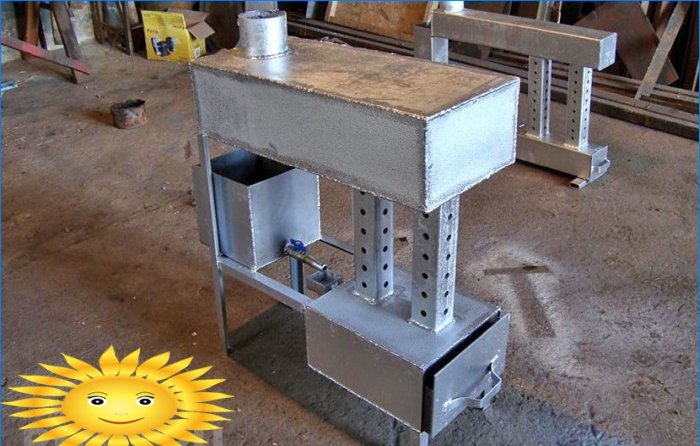
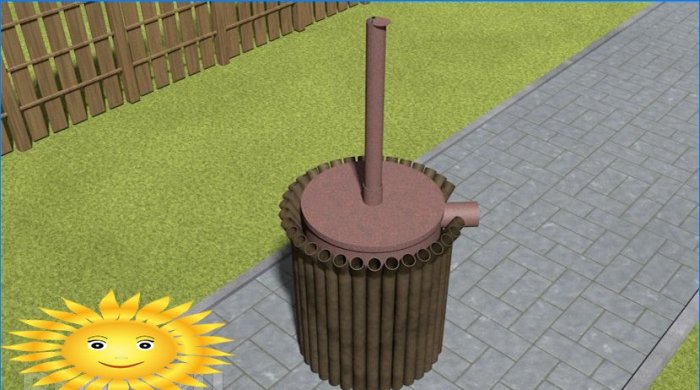
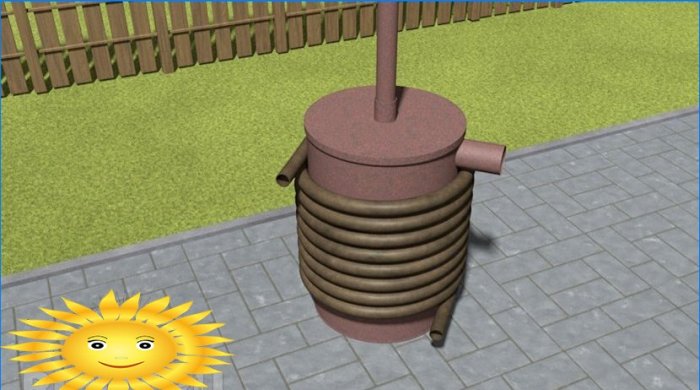

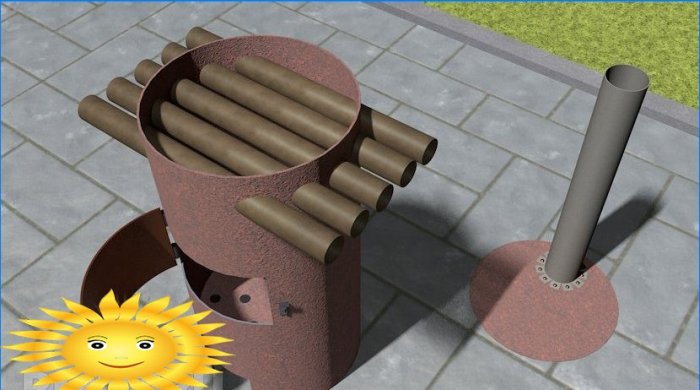
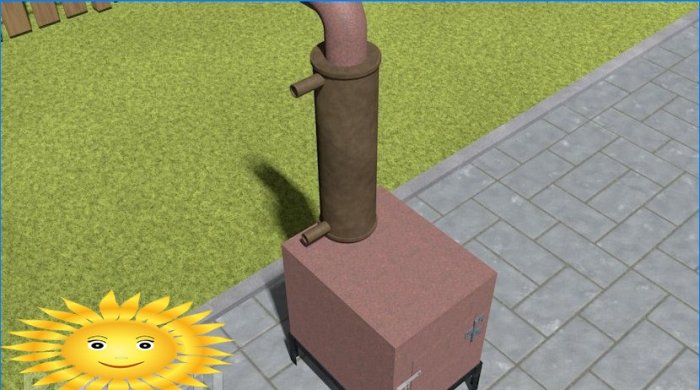
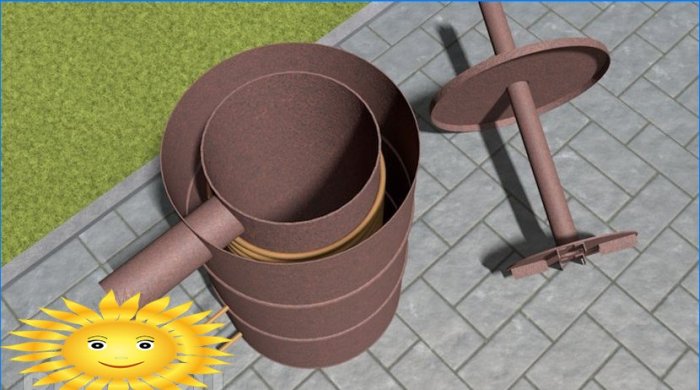
How can one effectively manufacture a heat exchanger for a potbelly stove? What are the important factors to consider in terms of materials, design, and construction techniques? Are there any specific guidelines or resources available for someone interested in this project?
How can I manufacture a heat exchanger for a potbelly stove? Could you provide any guidance or resources to help me with the process?
To manufacture a heat exchanger for a potbelly stove, you will need to consider a few key factors. Firstly, determine the heat exchanger’s design, dimensions, and material based on the available space and compatibility with high temperatures. Consider using copper or stainless steel due to their thermal conductivity and durability.
Next, create a design incorporating tubes or fins that will promote efficient heat transfer. Welding or soldering may be required to assemble the components. Ensure that the heat exchanger fits securely within the stove and allows for proper airflow.
For guidance and resources, you can refer to DIY websites, online forums, or instructional videos that showcase similar projects. Additionally, consulting with metal fabricators or experienced stove manufacturers can provide valuable insights and practical advice.
Remember to prioritize safety throughout the manufacturing process and test the efficiency of the heat exchanger before installation. Always comply with local regulations and guidelines to ensure a safe and effective potbelly stove.
Manufacturing a heat exchanger for a potbelly stove involves careful consideration of design, dimensions, and materials like copper or stainless steel. Efficient heat transfer is key, so incorporate tubes or fins in the design and securely fit the exchanger within the stove. Seek guidance from DIY resources, forums, or professionals, and prioritize safety and testing before installation. Comply with regulations for a safe and effective potbelly stove.